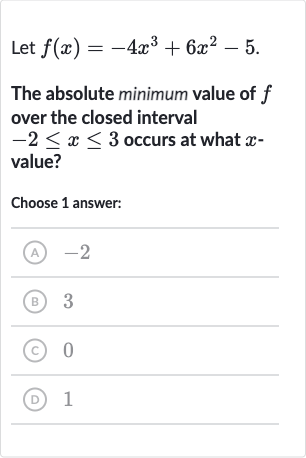Full solution
Q. Let .The absolute minimum value of over the closed interval occurs at what value?Choose answer:(A) (B) (C) (D)
- Find Critical Points: To find the absolute minimum value of the function on the closed interval , we first need to find the critical points of the function within the interval. Critical points occur where the derivative of the function is zero or undefined.
- Calculate Derivative: We calculate the derivative of ..
- Find Critical Points: Next, we find the critical points by setting the derivative equal to zero and solving for . or .
- Evaluate Function: We now have two critical points, and , within the interval . We also need to evaluate the function at the endpoints of the interval, which are and .
- Compare Values: We evaluate the function at the critical points and the endpoints:....
- Absolute Minimum Value: Comparing the values of at the critical points and endpoints, we find that the absolute minimum value occurs at , since is the smallest value.
- Absolute Minimum Value: Comparing the values of at the critical points and endpoints, we find that the absolute minimum value occurs at , since is the smallest value.The answer to the question prompt is that the absolute minimum value of the function over the interval occurs at .
More problems from Solve quadratic inequalities
QuestionGet tutor help
QuestionGet tutor help
QuestionGet tutor help
QuestionGet tutor help
QuestionGet tutor help
QuestionGet tutor help
QuestionGet tutor help
QuestionGet tutor help

